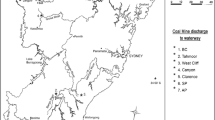Since the mid-1980s, cyanide in heap leach solutions and mill tailings ponds at gold mines in Nevada has killed a large but incompletely documented number of wildlife (>9,500 individuals, primarily migratory birds). This field investigation documents the availability of cyanide at a variety of ‘typical’ Nevada gold mines during 1990 and 1991, describes wildlife reactions to cyanide solutions, and discusses procedures for eliminating wildlife loss from cyanide poisoning. Substantial progress has been made to reduce wildlife loss. About half of the mill tailings ponds (some up to 150 ha) in Nevada have been chemically treated to reduce cyanide concentrations (the number needing treatment is uncertain) and many of the smaller heap leach solution ponds and channels are now covered with netting to exclude birds and most mammals. The discovery of a cyanide gradient in mill tailings ponds (concentration usually 2–3 times higher at the inflow point than at reclaim point) provides new insight into wildlife responses (mortality) observed in different portions of the ponds. Finding dead birds on the tops of ore heaps and associated with solution puddling is a new problem, but management procedures for eliminating this source of mortality are available. A safe threshold concentration of cyanide to eliminate wildlife loss could not be determined from the field data and initial laboratory studies. New analytical methods may be required to assess further the wildlife hazard of cyanide in mining solutions.
Similar content being viewed by others
References
Alberswerth, D., Carlson, C., Horning, J., Elderkin, S. and Mattox, S. (1992) Poisoned profits: cyanide heap leach mining and its impacts on the environment. Washington, DC: National Wildlife Federation.
Ballantyne, B. (1987) Toxicology of cyanide. In Ballantyne, B. and Marrs, T.C. eds. Clinical and Experimental Toxicology of Cyanides, pp. 41–126. Bristol, UK: Institute of Physics.
Clark, D.R.Jr., Hill, E.F., and Henry, P.F.P. (1991) Comparative sensitivity of little brown bats (Myotis lucifugus) to acute dosages of sodium cyanide. Abstr. N. Am. Symp. Bat Res. 21, 13.
Duke, G.E. (1986) Alimentary canal: secretum and digestion, special digestive functions, and absoption. In Sturkie, P.D. ed. Avian physiology, 4th Edn, pp. 289–302. New York: Springer-Verlag.
Duke, G.E., Jegers, A.A., Loff, G. and Evanson, O.A. (1975) Gastric digestion in some raptors. Comp. Biochem. Physiol. 50A, 649–56.
Eisler, R. (1991) Cyanide Hazards to Fish, Wildlife, and Invertebrates: A Synoptic Review. US Fish Wildlife Service, Biol. Rep. 85(1.23).
Finney, D.J. (1971) Probit analysis, 3rd Edn. Cambridge: Cambridge University Press.
Franson, M.A.H. (1989) Standard Methods for the Examination of Water and Wastewater, 17th Edn. Washington, DC: American Public Health Assoc., American Water Works Assoc. and Water Pollution Control Federation.
Hallock, R.J. (1990) Elimination of migratory bird mortality at gold and silver mines using cyanide extraction. In Proceedings Nevada Wildlife/Mining Workshop, pp. 9–17. Reno, NV: Nevada Mining Association.
Hill, E.F. and Camardese, M.B. (1984) Toxicity of anticholinesterase insecticides to birds: Technical grade versus granular formulations. Ecotoxicol. Environ. Safety 8, 551–63.
Hill, E.F., Henny, C.J., Clark, D.R.Jr. and Hallock, R.J. (1991) Toxicology and hazard to wildlife of cyanide from gold mining. Abstr. Soc. Environ. Toxicol. Chem. 12, 87.
Huiatt, J.L., Kerrigan, J.E., Olso, F.A. and Potter, G.L. (1983) Cyanide from Mineral Processing. Salt Lake City: Utah Mining and Mineral Resources Institute.
Jeffress, W.R. (1990) Waterfowl hazing techniques. In Proceedings Nevada Wildlife/Mining Workshop, pp. 42–45. Reno, NV: Nevada Mining Association.
McGill, S.L. (1990) A review of existing cyanide destruction procedures. In Proceedings Nevada Wildlife/Mining Workshop, pp. 101–104. Reno, NV: Nevada Mining Association.
Nevada Department of Wildlife (1992) Mining related wildlife mortalities on a per-mine basis continue downward trend. Mining Wildlife 1, 2–7.
Ritcey, G.M. (1989) Tailings Management. Problems and Solutions in the Mining Industry. Process Metallurgy 6. Energy, Mines and Resources Canada. CANMET. Amsterdam: Elsevier.
Simovic, L., Snodgrass, W.J., Murphy, K.L. and Schmidt, J.W. (1985) Development of a model to describe the natural degradation of cyanide in gold mill effluents. In Yan Zyl, D. (Ed.) Proceedings Conference on Cyanide and the Environment, Ft. Collins, Co: Colorado State University, Department of Civil Engineering.
Sterner, R.T. (1979) Effects of sodium cyanide and diphacinone in coyotes (Canis latrans): Applications as predicides in livestock toxic collars. Bull. Environ. Contam. Toxicol. 23 211–17.
US Department of Labor (1991) 1991 Metal Mines Address Listing with Workers and Employee Hours. 3rd Quarter. Mine Safety and Health Administration report.
Wiemeyer, S.N., Hill, E.F., Carpenter, J.W. and Krynitsky, A.J. (1986) Acute oral toxicity of sodium cyanide in birds. J. Wildlife Dis. 22, 538–46.
Author information
Authors and Affiliations
Rights and permissions
About this article
Cite this article
Henny, C.J., Hallock, R.J. & Hill, E.F. Cyanide and migratory birds at gold mines in Nevada, USA. Ecotoxicology 3, 45–58 (1994). https://doi.org/10.1007/BF00121387
Received:
Accepted:
Issue Date:
DOI: https://doi.org/10.1007/BF00121387




